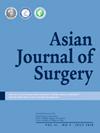高原居民胸外科术后症状性静脉血栓形成
IF 3.8
3区 医学
Q1 SURGERY
引用次数: 0
摘要
高海拔和环境变化被认为是导致静脉血栓形成事件(vte)的高危因素。目前尚不清楚海拔是否会影响术后静脉血栓栓塞的发生率。术后血栓预防包括早期下床活动和下肢间歇气动压缩(IPC)装置。预防性抗凝血药物未按常规使用。通过症状识别和下肢血管超声确认诊断有症状的静脉血栓栓塞。随后进行胸部计算机断层血管造影以确认是否有肺栓塞。结果共204例患者行胸外科手术。平均年龄42.6±16.9岁。患者平均居住海拔3663.7±538.7 m,其中红细胞37例(18.1%),高血红蛋白血症33例(16.2%),血小板增多症76例(37.3%)。6例(2.94%)患者术后出现症状性静脉血栓栓塞,未发现肺栓塞。静脉血栓栓塞(VTE)患者组的年龄和恶性疾病发生率(58.0比42.1岁,50.0%比13.6%)明显高于静脉血栓栓塞患者组。logistic回归分析显示高原居民术后静脉血栓栓塞无明显危险因素。结论高原居民胸外科手术后静脉血栓栓塞发生率不高。海拔高度和随后的变化不是术后静脉血栓栓塞的独立因素。术后血栓预防(早下床活动、IPC、无预防性抗凝药物使用)可有效预防高原居民术后症状性静脉血栓栓塞。本文章由计算机程序翻译,如有差异,请以英文原文为准。
Postoperative symptomatic venous thrombosis following thoracic surgery in high-altitude dwellers
Background
High altitude and environmental changes were considered as high-risk factors leading to venous thrombosis events (VTEs). It's unclear whether the high-altitude could influence the postoperative VTE incidence.
Methods
Patients' data between January 2014 and December 2022 was collected in department of thoracic surgery of People's Hospital of Ganzi Tibetan autonomous prefecture, which serving the population at geographic southeastern Tibetan Plateau. Postoperative thromboprophylaxis included early out-of-bed activity and intermittent pneumatic compression (IPC) device of lower limbs. Prophylactic anticoagulant drug wasn't used conventionally. Symptomatic VTE was diagnosed by symptom recognition and vascular ultrasonography confirmation of lower limbs. Chest computerized tomography angiography was subsequently performed to verify pulmonary embolism or not.
Results
Total 204 patients have undergone thoracic surgery. Mean age was 42.6 ± 16.9 years. Mean resident altitude of the patients was 3663.7 ± 538.7 m. 37 patients (18.1 %) had erythremia, 33 patients (16.2 %) had hyperhemoglobinemia, and 76 patients (37.3 %) had thrombocythemia. Six patients (2.94 %) had postoperative symptomatic VTE, and no pulmonary embolism was found. The age and malignant disease found significantly higher (58.0 vs. 42.1 years, 50.0 % vs.13.6 % respectively) in VTE patient group. Logistical regression showed no significant risk factor of postoperative VTE of high-altitude dwellers.
Conclusions
The high-altitude dwellers didn't seem to have much high symptomatic VTE tendency after thoracic surgery. The high altitude and subsequent changes were not independent factors of postoperative VTE. The postoperative thromboprophylaxis (early out-of-bed activity, IPC, and no prophylactic anticoagulant drug use) were effective preventing postoperative symptomatic VTE for high-altitude dwellers.
求助全文
通过发布文献求助,成功后即可免费获取论文全文。
去求助
来源期刊

Asian Journal of Surgery
医学-外科
CiteScore
3.60
自引率
31.40%
发文量
1589
审稿时长
33 days
期刊介绍:
Asian Journal of Surgery, launched in 1978, is the official peer-reviewed open access journal of the Asian Surgical Association, the Taiwan Robotic Surgery Association, and the Taiwan Society of Coloproctology. The Journal is published monthly by Elsevier and is indexed in SCIE, Medline, ScienceDirect, Scopus, Embase, Current Contents, PubMed, Current Abstracts, BioEngineering Abstracts, SIIC Data Bases, CAB Abstracts, and CAB Health.
ASJSUR has a growing reputation as an important medium for the dissemination of cutting-edge developments in surgery and its related disciplines in the Asia-Pacific region and beyond. Studies on state-of-the-art surgical innovations across the entire spectrum of clinical and experimental surgery are particularly welcome.
The journal publishes original articles, review articles, and case reports that are of exceptional and unique importance. The journal publishes original articles, review articles, and case reports that are of exceptional and unique importance.
 求助内容:
求助内容: 应助结果提醒方式:
应助结果提醒方式:


